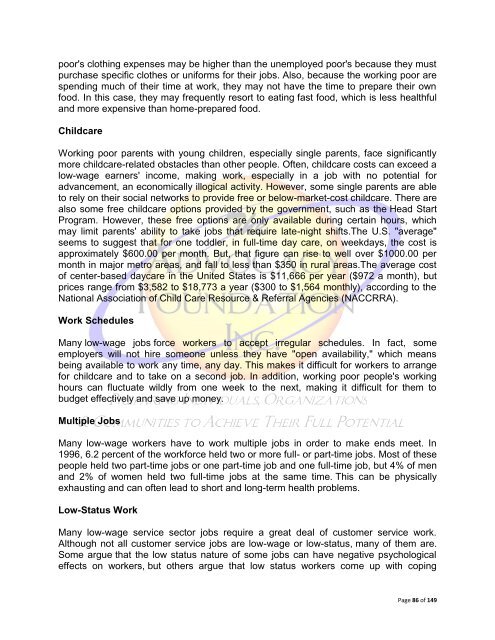Hidden Unemployment
Hidden Unemployment
Hidden Unemployment
You also want an ePaper? Increase the reach of your titles
YUMPU automatically turns print PDFs into web optimized ePapers that Google loves.
poor's clothing expenses may be higher than the unemployed poor's because they must<br />
purchase specific clothes or uniforms for their jobs. Also, because the working poor are<br />
spending much of their time at work, they may not have the time to prepare their own<br />
food. In this case, they may frequently resort to eating fast food, which is less healthful<br />
and more expensive than home-prepared food.<br />
Childcare<br />
Working poor parents with young children, especially single parents, face significantly<br />
more childcare-related obstacles than other people. Often, childcare costs can exceed a<br />
low-wage earners' income, making work, especially in a job with no potential for<br />
advancement, an economically illogical activity. However, some single parents are able<br />
to rely on their social networks to provide free or below-market-cost childcare. There are<br />
also some free childcare options provided by the government, such as the Head Start<br />
Program. However, these free options are only available during certain hours, which<br />
may limit parents' ability to take jobs that require late-night shifts.The U.S. "average"<br />
seems to suggest that for one toddler, in full-time day care, on weekdays, the cost is<br />
approximately $600.00 per month. But, that figure can rise to well over $1000.00 per<br />
month in major metro areas, and fall to less than $350 in rural areas.The average cost<br />
of center-based daycare in the United States is $11,666 per year ($972 a month), but<br />
prices range from $3,582 to $18,773 a year ($300 to $1,564 monthly), according to the<br />
National Association of Child Care Resource & Referral Agencies (NACCRRA).<br />
Work Schedules<br />
Many low-wage jobs force workers to accept irregular schedules. In fact, some<br />
employers will not hire someone unless they have "open availability," which means<br />
being available to work any time, any day. This makes it difficult for workers to arrange<br />
for childcare and to take on a second job. In addition, working poor people's working<br />
hours can fluctuate wildly from one week to the next, making it difficult for them to<br />
budget effectively and save up money.<br />
Multiple Jobs<br />
Many low-wage workers have to work multiple jobs in order to make ends meet. In<br />
1996, 6.2 percent of the workforce held two or more full- or part-time jobs. Most of these<br />
people held two part-time jobs or one part-time job and one full-time job, but 4% of men<br />
and 2% of women held two full-time jobs at the same time. This can be physically<br />
exhausting and can often lead to short and long-term health problems.<br />
Low-Status Work<br />
Many low-wage service sector jobs require a great deal of customer service work.<br />
Although not all customer service jobs are low-wage or low-status, many of them are.<br />
Some argue that the low status nature of some jobs can have negative psychological<br />
effects on workers, but others argue that low status workers come up with coping<br />
Page 86 of 149

















